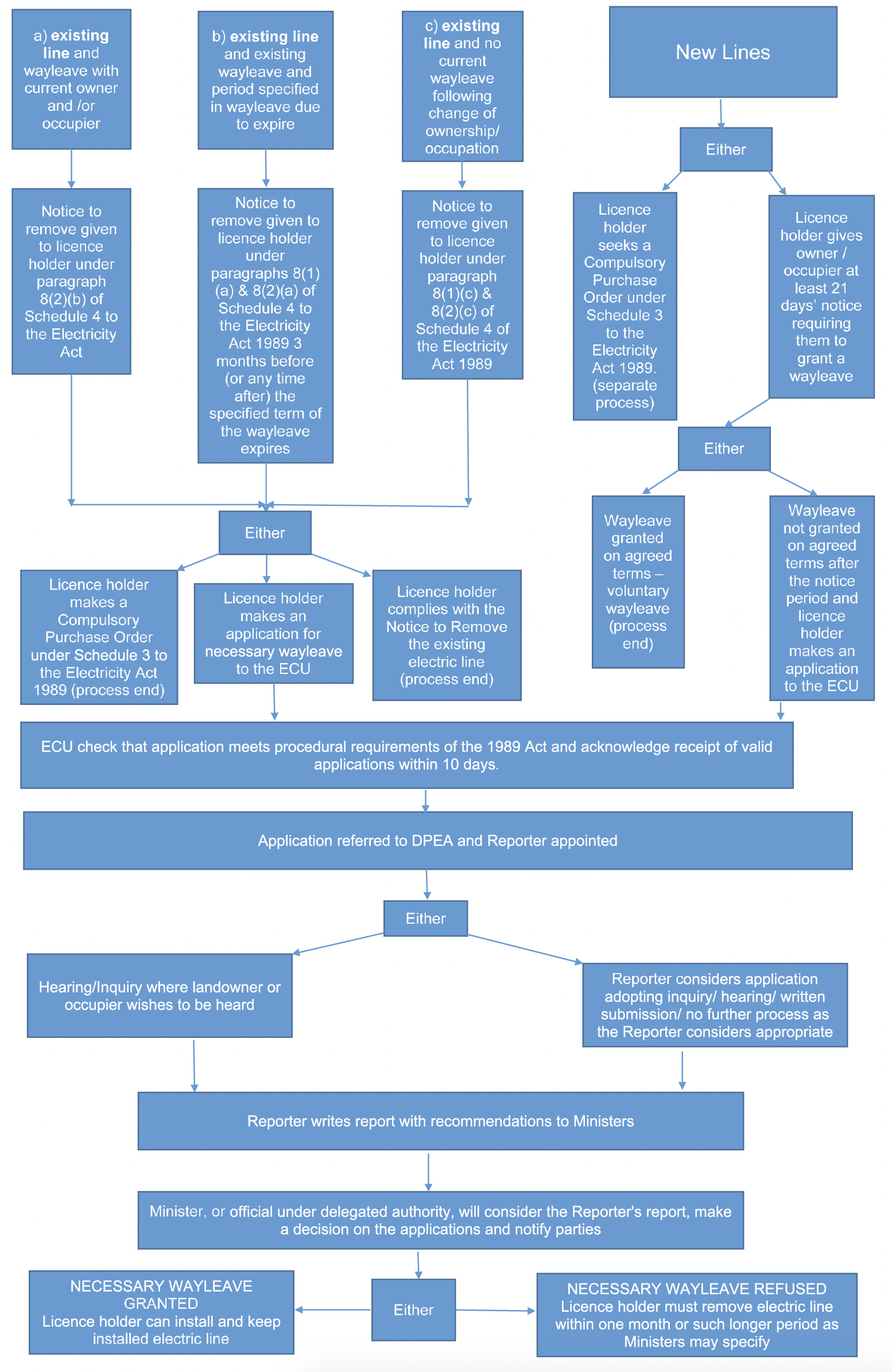Electricity - necessary wayleaves: guidance for applicants, landowners and occupiers – 2022 update
Guidance on the procedure adopted by the Scottish Ministers in receiving and determining applications by network operators under the Electricity Act 1989 for necessary wayleaves, to retain or place electric lines on land. The guidance was updated in March 2022.
Introduction
Electricity Licence Holders and Compulsory Procedures
1. The electricity networks feed electricity to nearly all of the households and businesses in Scotland. The networks are operated by electricity transmission and distribution companies, who are electricity licence holders. Electricity licence holders have general duties contained in section 9 of the Electricity Act 1989 ("the 1989 Act") to develop and maintain an efficient, co-ordinated and economical system of electricity distribution and transmission and to facilitate competition in the supply and generation of electricity.
2. Electricity licence holders operate under a regulatory regime which gives them access to the compulsory acquisition powers set out in section 10 and Schedules 3 and 4 to the 1989 Act. These powers enable licence holders to comply with their statutory duties and obligations.
3. Licence holders need rights to install and keep their electric lines and associated equipment (such as poles, pylons, staywires and transformers) on, over or under private land and to have access to that land for the purpose of inspecting, maintaining, repairing, adjusting, altering, replacing or removing the electric line or equipment. Commonly, electricity licence holders do this through negotiation of a contractual arrangement with the landowner and/or the occupier of the land.
4. However, where an agreement has not been reached through negotiation, licence holders have access to compulsory procedure. They may promote a compulsory purchase order under Schedule 3 to the 1989 Act or may apply for a compulsory wayleave (the legislation uses the terms "necessary wayleave") under Schedule 4 to the 1989 Act.
Compulsory Purchase Orders
5. Compulsory purchase orders can be used, where appropriate, for the installation and retention of electric lines, or other purposes allowed for by statute. In such cases, the licence holder will make an Order for the compulsory acquisition of land or rights over land, and then seek confirmation of the Order from the Scottish Ministers. Where statutory objections are raised, (i.e. objections from landowners, lessees or occupiers) the Scottish Ministers are required to give statutory objectors an opportunity of being heard before confirming the Order. The procedure for making a compulsory purchase order is set out in legislation (the 1989 Act and the Acquisition of Land (Authorisation Procedure) (Scotland) Act 1947). Inquiries into objections to compulsory purchase orders are held in accordance with the Compulsory Purchase by Public Authorities (Inquiries Procedure) (Scotland) Rules 1998.
6. The Scottish Government has issued separate guidance for stakeholders on the use of compulsory purchase orders, which is out with the scope of this guidance. A link to guidance documents produced by the Scottish Government on the compulsory purchase order process is at the end of this paragraph. Clicking the link will take you to the gov.scot page entitled 'Compulsory purchase orders: introduction' Compulsory purchase orders: introduction - gov.scot (www.gov.scot).
Necessary Wayleaves
7. Alternatively, rights to install a new electric line or retain an existing electric line can be achieved by applying to the Scottish Ministers for a necessary wayleave under Schedule 4 to the 1989 Act. It is usual, but not mandatory, for licence holders to try to negotiate a voluntary wayleave or a servitude with landowners and/or occupiers of land before invoking this more formal necessary wayleave process under Schedule 4 to the 1989 Act.
8. A necessary wayleave is a statutory right which confers powers on the licence holder to install their electric lines and associated equipment on, over or under private land, to keep the electric line there and to have access to that land for the purposes of inspecting, maintaining, repairing, adjusting, altering, replacing or removing the electric line or equipment. The necessary wayleave confers only those rights over land. It does not confer planning permission or any other development consent which might be required for a particular project.
9. Once granted, the necessary wayleave will remain in force for the period specified in the wayleave itself (this can be for a period of up to 40 years, but the duration of the rights may vary from case to case as circumstances dictate). Throughout the period that a necessary wayleave is in place, it is enforceable by the licence holder against subsequent landowners or occupiers, if the land is sold or the occupant changes during the period.
10. The procedure for applications for necessary wayleaves is set out in Schedule 4 to the 1989 Act. Guidance on the necessary wayleave process is provided in more detail in the following sections. A flowchart, on the following page, sets out the process to be followed in all the different circumstances where the necessary wayleave provisions may be invoked by an applicant, landowner or occupier.
11. Once a necessary wayleave has been granted, Ministers have no role in monitoring or enforcement of it. Entry by a licence holder on to land without requisite property rights or in breach of a condition attached to a necessary wayleave is a matter between the parties.

Contact
Email: econsents_admin@gov.scot
There is a problem
Thanks for your feedback